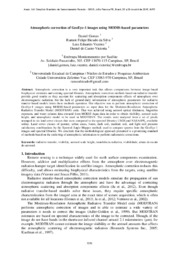Atmospheric correction of GeoEye-1 images using MODIS-based parameters.
Atmospheric correction of GeoEye-1 images using MODIS-based parameters.
Author(s): LOEBMANN, D. G. dos S. W.; SILVA, R. F. B. DA; VICENTE, L. E.; VICTORIA, D. de C.
Summary: Atmospheric correction is a very important task that allows comparisons between image-based biophysical estimates and existing spectral libraries. Atmospheric correction methods based on radiative transfer provide good results as they account for scattering and absorption components effects of atmosphere over electromagnetic radiation, but the lack of ground-daily information of atmospheric parameters for radiative transfer-based models limits these methods operation. Our objective was to perform atmospheric correction of GeoEye-1 images using MODIS-based parameters as input data for the Moderate-Resolution Atmospheric Radiative Transfer Model (MODTRAN) code. That was achieved using aerosol optical thickness, Ångström exponent, and water column data extractd from MODIS Aqua data in order to obtain visibility, aerosol scale height, and atmospheric model to be used in MODTRAN. The results were analyzed from a set of pixels arranged in six land cover classes that were compared to the spectral libraries USGS and NASA/JPL, available online. Land cover classes of pasture, urban areas, forest, dark soil, medium soil, and light soil presents satisfactory combinations by the Spectral Angle Mapper method, used to compare spectra from the GeoEye-1 images and spectral libraries. We conclude that the methodological approach presented is a promising standard of methods based on the retrieving of atmospheric information to perform radiometric corrections.
Publication year: 2015
Types of publication: Paper in annals and proceedings
Unit: Embrapa Territorial
Observation
Some of Embrapa's publications are published as ePub files. To read them, use or download one of the following free software options to your computer or mobile device. Android: Google Play Books; IOS: iBooks; Windows and Linux: Calibre.
Access other publications
Access the Agricultural Research Database (BDPA) to consult Embrapa's full library collection and records.
Visit Embrapa Bookstore to purchase books and other publications sold by Embrapa.

